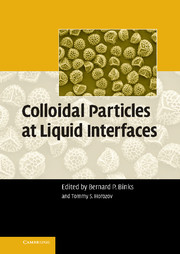Book contents
- Frontmatter
- Contents
- Preface
- List of Contributors
- 1 Colloidal Particles at Liquid Interfaces: An Introduction
- Section 1 Particles at Planar Liquid Interfaces
- Section 2 Particles at Curved Liquid Interfaces
- 5 Particle-Laden Interfaces: Rheology, Coalescence, Adhesion and Buckling
- 6 Solids-Stabilized Emulsions: A Review
- 7 Novel Materials Derived from Particles Assembled on Liquid Surfaces
- 8 Interfacial Particles in Food Emulsions and Foams
- 9 Collection and Attachment of Particles by Air Bubbles in Froth Flotation
- 10 Antifoam Effects of Solid Particles, Oil Drops and Oil—Solid Compounds in Aqueous Foams
- 11 Metal Foams: Towards High-Temperature Colloid Chemistry
- Index
11 - Metal Foams: Towards High-Temperature Colloid Chemistry
Published online by Cambridge University Press: 11 October 2009
- Frontmatter
- Contents
- Preface
- List of Contributors
- 1 Colloidal Particles at Liquid Interfaces: An Introduction
- Section 1 Particles at Planar Liquid Interfaces
- Section 2 Particles at Curved Liquid Interfaces
- 5 Particle-Laden Interfaces: Rheology, Coalescence, Adhesion and Buckling
- 6 Solids-Stabilized Emulsions: A Review
- 7 Novel Materials Derived from Particles Assembled on Liquid Surfaces
- 8 Interfacial Particles in Food Emulsions and Foams
- 9 Collection and Attachment of Particles by Air Bubbles in Froth Flotation
- 10 Antifoam Effects of Solid Particles, Oil Drops and Oil—Solid Compounds in Aqueous Foams
- 11 Metal Foams: Towards High-Temperature Colloid Chemistry
- Index
Summary
Introduction
Liquid foams are collections of gas bubbles uniformly dispersed in fluids and separated from each other by self-standing thin films. If the distance between bubbles is comparable to the bubble size one prefers to speak of bubble dispersions. In foams, bubble arrangements are usually disordered and gas volume fractions are high. If a liquid foam is solidified, a solid foam is obtained. Solid foams show many interesting properties which is the reason for their wide use, e.g. in civil engineering, chemistry or the food industry.
Any liquid matter should be foamable and so is liquid metal. The prospect of being able to make light durable metallic foams already triggered research more than half a century ago. In 1943 Benjamin Sosnick attempted to foam aluminium with mercury. He first melted a mix of Al and Hg in a closed chamber under high pressure. The pressure was released, leading to vaporisation of the mercury at the melting temperature of aluminium and to the formation of a foam. Less hazardous processes were developed in the mid-1950s when it was realised that liquid metals could be more easily foamed if they were pre-treated to modify their properties. This could be done by oxidising the melt or by adding solid particles.
- Type
- Chapter
- Information
- Colloidal Particles at Liquid Interfaces , pp. 445 - 500Publisher: Cambridge University PressPrint publication year: 2006
- 6
- Cited by



